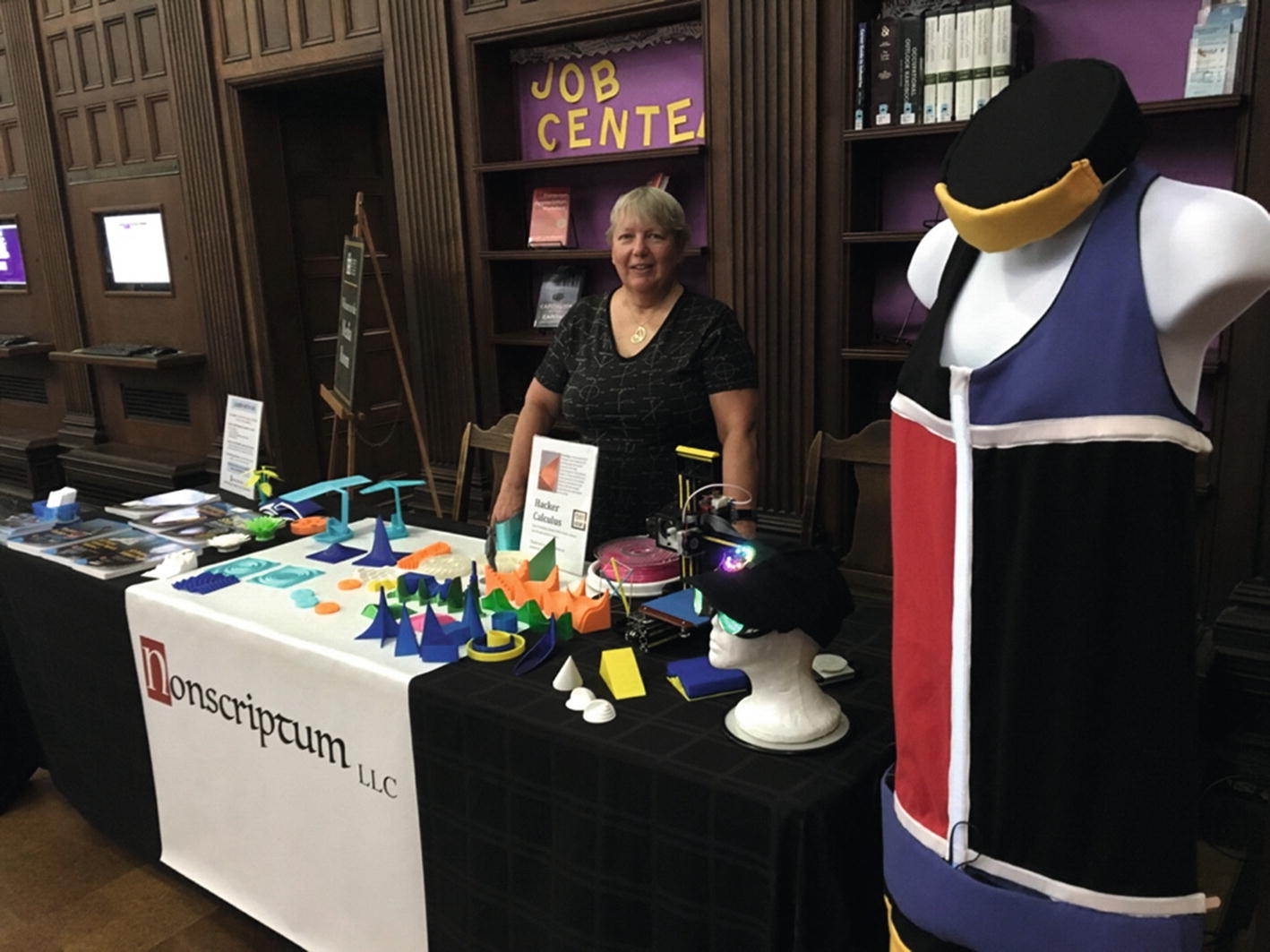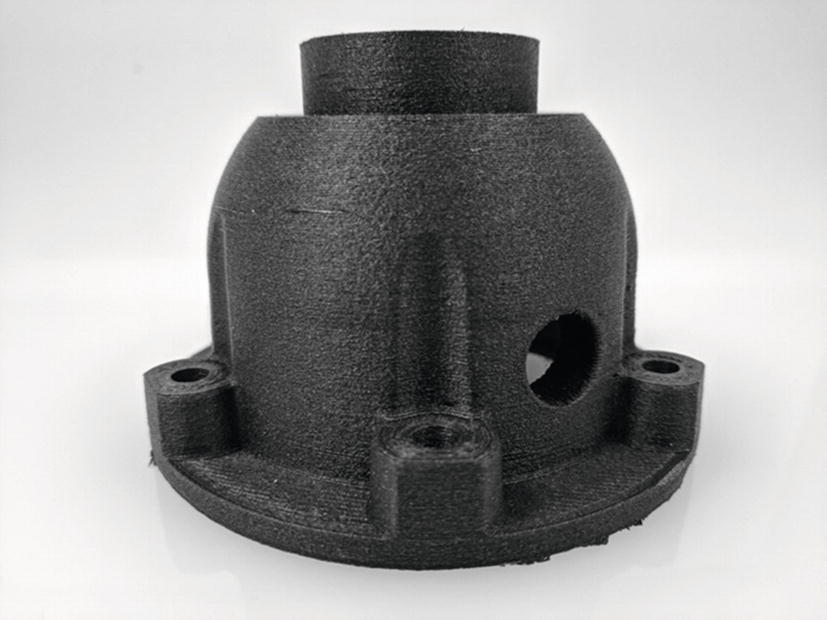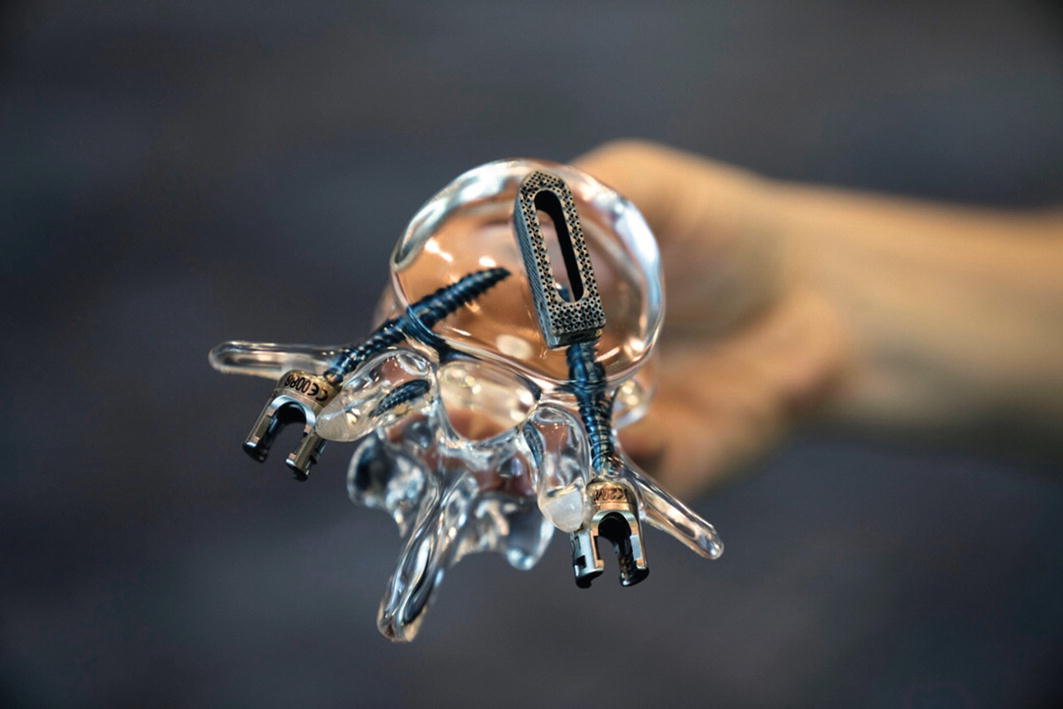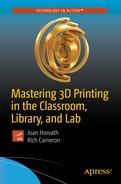We are often asked what types of 3D printing–related jobs will be available in the future. Since it is pretty challenging to predict where the industry will go in the next couple of years, much less in a decade or two, any attempt to answer should be taken with a large grain of salt. Any 3D printer that a student uses now will have very little resemblance to an industrial printer used for metal parts. However, the skill of being able to envision something, create a computer model of it, and then transform that into a physical object will always be a valuable one.
Note
We have found that many people coming into this space are comfortable with either the computer design part of it or the physical fabrication. People comfortable with both are less common. This is one reason that we encourage having students run their own print jobs, once they are old enough. There is no substitute for actual experience making things—it is like the difference between watching someone play a sport and trying it yourself.
What, then, is the best way to approach preparing students for the economy they are likely to work in? First, training in technical subjects is always a basic requirement, and figuring out how to make a physical part that will hold together and do whatever it is supposed to do is a great way to teach many engineering basics. The physicality of the product (instead of something on a screen) can also help students think about making a product useful and attractive (or even fun) instead of just creating something that can support a load. For students thinking about a career in the arts, digital manufacturing can increase their reach in a new medium. Finally, physically creating something often requires teamwork to bring together the many strengths needed for successful maker projects. Sometimes student team projects can seem contrived, but to make something, teams will often form organically, because so many skills are typically needed.
Student Entrepreneurship
Who owns the designs invented at school, whether for a school project or something else?
Can students use school materials to make ten of something for their friends, if they do not charge for it?
Can students bring materials in and use school printers (or other equipment) to make things they then subsequently sell?
Are there tax and liability implications for the student and/or the school?
We cover some of the practicalities of running a 3D printer and its facilities needs in Chapter 5. Take a look particularly at the “Where Should We Put It?” Section.
Tip
Schools need to decide whether they can encourage and support entrepreneurship, and how far they can go in that support. Universities have wrestled with this for a long time (the department that handles these things is usually called the “technology transfer” or “licensing” group), and if you want to encourage this in a big way, you might talk to a local university tech transfer office that knows your school system and community.
Students might learn about these technologies at school and want to start a business at home. If the student’s parents are able to provide a printer and supplies and give them access to legal and tax advice, then there are a variety of marketplaces (like www.tindie.com and www.etsy.com ) that might serve as outlets. A crowdfunding site (like Kickstarter, www.kickstarter.com ) can be an option for more ambitious ideas.
Caution
It is important to stay realistic. Making, marketing, and selling a product are not easy, and standard business advice of keeping overhead low applies. If a product is successful, keeping up with demand and doing the printing, packing, and shipping can become substantial endeavors. Many Kickstarter campaigns fail to deliver after being funded because their creator did not properly budget for their time and all the other expenses, beyond raw materials, that would be required to deliver on their promises. And of course, there is always the risk that the idea will be copied by someone bigger if it is very successful.
This all sounds very exciting and like the classic company-in-a-garage dream. What happens, though, if the student’s parents cannot afford to capitalize equipment or pay for a bit of legal or accounting advice? Age limits on various business activities such as selling on a site can be an issue, too, if there is no parent support of the young entrepreneur, and this is likely to vary in different states and countries, too. Such students may be creating jobs for themselves in an area where jobs are few and far between, but they will need some help to get going.
There are charter schools like Prime School in Los Angeles ( www.primeschool.org , planned for launch in 2019) that have entrepreneurship in high-poverty areas as a core focus. The availability of both maker tools and Internet selling platforms has dramatically lowered the cost of entry for product entrepreneurs and 3D-printing service providers. Schools are starting to look to leverage these tools for student and community benefit. We hope that the business and maker community will help these entrepreneurs use maker tech and Internet tools to create enterprises where there were none before.
Note
The business of using consumer 3D printers to print jobs for the general public has become rather low-margin, at least in California where competition has driven down prices. Sites like www.3dhubs.com let printer owners bid on printing jobs that people post, and anecdotally bids seem to be quite reasonable now for straightforward prints in PLA. This is good for the consumer wanting something printed and for someone doing it in their garage for extra money. It is a low-margin business, particularly because print files submitted often need some substantial rework before printing. We suspect that many of these are teens doing print jobs as an alternative to mowing lawns, and we have dubbed this phenomenon the “digital lemonade stand.” Professional service bureaus seem to be migrating more to specialized prints that require expensive equipment, or to combining scanning, 3D design, and printing services under one roof.
Public Library Makerspaces
Numerous public libraries have been putting in makerspaces for their communities. In many cases, the presumption is that the majority of users will be children and teens, and the “teen librarian” often seems to be the one who winds up managing it. Obviously, adults wanting to retrain themselves can be beneficiaries, too (learning either the computer or hands-on skills or both). For some reason, 3D printers are often seen by libraries as a kid thing, which we think is too limiting.
The issues we mention earlier in the chapter for schools also apply to a library. The situation is a little different, though, in that a library is intended to be a public resource. The question becomes how much any one person can monopolize the resource, and how the makerspace can sustain itself if it does not have long-term funding.
Libraries have to decide whether they want to be at-cost or no-cost 3D printing and perhaps laser-cutting service bureaus for the community, for example, and whether that puts them in competition with for-profit local businesses. Setting priorities for printer access and policies about what can be printed are important, too. Finally, there will need to be a process to be sure that the right materials are used with any maker machinery. See Chapter 1 for laser cutter concerns and Chapter 2 for 3D-printer materials compatibility.
Some libraries are older civic buildings, and finding a place that has power, that can keep the equipment secure, and that has adequate ventilation can be a challenge. Often there is money donated to buy equipment, but not to renovate any space or train staff. This can require a bit of creativity.
Caution
Unfortunately, sometimes schools or libraries have equipment donated that does not work or that is more expensive to run than a newer machine might be. If you are in charge of a nonprofit makerspace, ask gentle questions if your donors are giving you used equipment. Otherwise, a lot of staff time and frustration can be spent trying to get something broken to work when you assume it is you or your staff, not the equipment, that is the problem. Or you might have trouble finding proprietary materials if the machine is no longer made.
Libraries can play a key role in letting the public know what it is possible to do with low-cost 3D printers and other maker technologies, such as small electronics. Figure 14-1 shows Joan running a demonstration table with a lot of 3D prints and some fashion tech electronics demonstration. This event was at the Pasadena Public Library’s official grand opening of its makerspace. Often people need some inspiration to understand the possibilities, so if you are a librarian opening a space, reach out to local groups to display what they are doing to inspire everyone. Competitions and displays of finished projects are a great way to invite community involvement, too.

Joan demonstrating various types of maker tech at a library
Digital Fabrication Career Opportunities
What a student learns on a small consumer 3D printer may not transfer directly to more sophisticated industrial machines, but the intuition helps. Today, 3D printing is being used in a few applications where it adds a lot of value. In this section, we list some typical applications, both to survey the state of the art and perhaps suggest areas for student projects or research to prepare for entering the industry someday. As experience and appropriate automation grow, this list is likely to grow as well.
Prototyping
3D printing has been used for prototyping for decades, and that remains a major application. Now that there are many materials that can be 3D printed (Chapter 2), it is a lot easier to create a model that mimics the form and fit of a product to see how it feels or works with other parts.

Carbon fiber filament part (part courtesy of MAKEiT, Inc.)
Bridge Manufacturing
Manufacturers often use “just in time” methods to keep parts in stock. This means that they do not keep a lot of inventory on hand, and sometimes a whole line will have to stop to wait for a part. To get through that and keep the line running, manufacturers turn to bridge parts, made in some other way than the regular process.
Since there are so many materials now, the bridge parts can often be 3D printed in the same material as the production part. This means, in turn, that the finished product can be shipped with the bridge part, and it might not need to be replaced (if quality control requirements allow use of a 3D printed part).
Short-Run Manufacturing
The next step up from bridge manufacturing is to plan to 3D print your manufacturing run of parts in the first place. Some of the early adopters of this were, not surprisingly, the 3D-printer manufacturers themselves. Figure 14-3 shows 3D-printer manufacturer MAKEiT’s in-house product facility doing a short run of custom speaker housings designed by Russell Singer, one of the staff.
Printing the same parts over and over can be pretty efficient, since it is worth it to really optimize the printer settings and then just launch the same job over and over. However, 3D printing can be slow for some applications, and the issues with being able to model a part’s mechanical properties to a high enough fidelity might be problematic in some applications.
Tip
Because it is possible to 3D print shapes that would be difficult or impossible to manufacture by more conventional methods, you may be able to print what would otherwise be a complicated assembly in far fewer pieces, saving worker time.

Short-run manufacturing (courtesy of Russell Singer/ MAKEiT, Inc.)
Mass Customization
It is not a big step to go from manufacturing a small number of identical parts one at a time to asking whether one can make a standard part customizable instead. A CAD model might have just a few parameters that can be tweaked depending on what the user needs, or the individual product might be made from a scan.
Dentists have been early adopters of this approach, since almost all of what they do is custom to every patient. Most of the current dental applications use resin printers to create devices that do not go in the mouth themselves but are used as molds for casting, vacuum forming, or other technologies.

3D Systems ProX ® DMP 320 printers and K2M’s advanced methodologies called Lamellar 3D Titanium Technology™ enable K2M to produce structures in its CASCADIA™ Interbody Systems that provide both porosity and surface roughness to allow for bone growth (image courtesy of 3D Systems)
3D printed fashion (notably shoes and high fashion at this point) is in its early days, and is mostly used for prototyping or high-visibility pieces for celebrity clients or athletes. A 3D printed dress created by designer Michael Schmidt ( www.michaelschmidtstudios.com ) and technologist Francisco Bitoni for Dita von Teese was an early (rather revealing) printed lacework-like dress.
Designers Nervous System ( https://n-e-r-v-o-u-s.com ) created the “Kinematic Dress,” which, like chain armor, folds up for printing (on an SLS machine) and then flows nicely for the wearer. Other novel, 3D printed high fashion has been created by Anouk Wipprecht ( www.anoukwipprecht.nl )—famously, her “Spider Dress,” which attacked anyone who got too close with animatronic legs. In the next section, we will look at creating jewelry by using 3D prints as a mold.
Note
We can think of these applications as “hardware as a service,” in which a digital file can be tweaked and manufactured anyplace an appropriate fabrication machine exists.
Industrial Moldmaking
A somewhat more conventional application of 3D prints is as forms or molds. Either a 3D printed part can be used as the positive to create a negative mold, or a negative mold can be created with 3D printing directly. PLA or specially formulated resins are commonly used to make jewelry from 3D prints via investment (or lost-wax) casting. In this process, a positive mold called a pattern is created, and then ceramic is laid up around it. The ceramic is fired, and the wax, resin, or PLA melts out. Then metal is poured in to make the jewelry piece. Finally, the ceramic mold must be broken to remove the metal piece, so each one can only be used once.
Beginning the process again would traditionally involve carving a new wax pattern that will inevitably end up slightly different from the first. However, a 3D printed pattern can be reproduced precisely just by running the print again. You can change some numbers in the CAD file if it was not quite right and try again, or customize the design for another client.
There is some early work by Formlabs to create a resin that can be used for injection molds. As this evolves, it might enable lower-volume injection molding runs, since this drastically lowers tooling costs and turnaround time.
Tip
Trying out 3D printed tooling or other in-house parts is a good way to test out 3D printing with something that is not going to a customer.
Direct Metal 3D Printing
At the moment, printing directly in metal is a challenging process, requiring sophisticated facilities management. However, ways around that are being explored, as we mention in Chapter 2. Metal 3D printing has incredible promise for making complex, multi-element parts that will be light and very reliable.
We expect that technology development for and applications of the various types of metal printing will continue to grow rapidly. Manufacturer 3D Systems ( www.3dsystems.com ) has many good case studies on its website.
Summary
In this chapter, we started out by framing the issues for student entrepreneurship in school or in enterprises that might be spun out from a school project. Next, we thought about libraries and how these community centers might foster local entrepreneurs. Finally, we surveyed the state of the practice of the use of 3D printing in industry to provide some ideas to guide preparation of the future stars of the design studio and factory floor.
